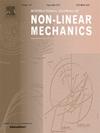Nonlinear thermal radiation effects on bioconvection nano fluid flow over a convectively heated plate
IF 2.8
3区 工程技术
Q2 MECHANICS
International Journal of Non-Linear Mechanics
Pub Date : 2025-01-07
DOI:10.1016/j.ijnonlinmec.2024.105010
引用次数: 0
Abstract
Nonlinear density variation and nonlinear thermal radiation's effects on the bioconvection of a nano-liquid film in a convectively heated channel are examined in this article. This article examines a thin film that gravitationally pulls along a channel, containing both nanoparticles and gyrotactic bacteria. By using similarity transformations, the governing partial differential equations for momentum, energy, nanoparticle concentration, and microbe density are transformed into ordinary differential equations and numerically solved using the legendary spectral collocation method in Mathematica and demonstrate its efficiency and accuracy in modeling complex flow behaviors. The findings demonstrate that while nonlinear density effects are essential for enhancing nanoparticle dispersion and bioconvection patterns, nonlinear thermal radiation greatly improves heat transfer and fluid velocity. Numerous flow parameters' effects on the flow profiles are investigated, including the parameter of Brownian motion, the Rayleigh number for bioconvection, and the density parameters of nonlinear motile microorganisms. The outcomes show that the influence of nonlinear parameters increases heat and mass efficiency transmission in the system by reducing temperature and concentration gradients. The study provides useful information on how to enhance cooling techniques and energy efficiency for a range of industrial applications, such as solar panels, thermal regulation in electronics, and chemical processes. Additionally, it highlights the potential application of gyrotactic microorganisms in conjunction with nanofluids to enhance pollutant removal in environmental systems.
求助全文
约1分钟内获得全文
求助全文
来源期刊
CiteScore
5.50
自引率
9.40%
发文量
192
审稿时长
67 days
期刊介绍:
The International Journal of Non-Linear Mechanics provides a specific medium for dissemination of high-quality research results in the various areas of theoretical, applied, and experimental mechanics of solids, fluids, structures, and systems where the phenomena are inherently non-linear.
The journal brings together original results in non-linear problems in elasticity, plasticity, dynamics, vibrations, wave-propagation, rheology, fluid-structure interaction systems, stability, biomechanics, micro- and nano-structures, materials, metamaterials, and in other diverse areas.
Papers may be analytical, computational or experimental in nature. Treatments of non-linear differential equations wherein solutions and properties of solutions are emphasized but physical aspects are not adequately relevant, will not be considered for possible publication. Both deterministic and stochastic approaches are fostered. Contributions pertaining to both established and emerging fields are encouraged.

 求助内容:
求助内容: 应助结果提醒方式:
应助结果提醒方式:


